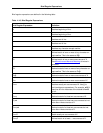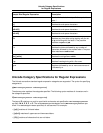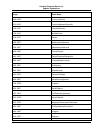
Sample Brief Regular Expression Description
tice that the backslash must prefix the special char-
acter *.
[\t ] Matches tab and space characters.
[\d9\d32] Matches tab and space characters.
[\x9\x20] Matches tab and space characters.
p?t Matches any three-letter string starting with the let-
ter p and ending with the letter t. Two possible
matches are pot and pat.
s*t Matches the letter s followed by any number of
characters followed by the nearest letter t. Two pos-
sible matches are seat and st.
{for}|{while} Matches the strings for or while.
^\:p Matches lines beginning with a file name.
xy+z Matches x followed by one or more occurrences of
y followed by z.
Unicode Category Specifications for Regular Expressions
The Unicode consortium standard regular expression categories are supported. The syntax for specifying
categories is:
\p{MainCategoryLetter Subcategories}
The above syntax matches the categories specified. The following syntax matches all characters not in
the categories specified:
\P{MainCategoryLetter Subcategories}
The \p and \P notations can only be used inside a character set specification. MainCategoryLetter
can be L, M, N, P, S, Z, or C. The valid Subcategories depend on the MainCategoryLetter spe-
cified. If no Subcategories are specified, all are assumed. For example:
• [\p{L}] matches all Unicode letters.
• [\p{Lul}] matches all uppercase and lowercase letters.
• [\P{L}] matches all characters that are not letters.
Unicode Category Specifications
for Regular Expressions
537


















